TO LEARN IS TO GROW
Learning Center
We do our research and publish our results. Should probably call this the Growing Center.


9 Hot WordPress Trends We’ll Continue To See in 2020
WordPress is a great platform for building websites. Anyone can get a copy of WordPress (it’s free!) and from its humble beginnings as a blogging publishing system in 2003, WordPress now powers 35% of the internet in 2020, up two percent compared to the previous year.
Today, a lot of the world’s most well-known brands run on WordPress. We’re talking about media websites, Fortune 500 companies, online stores, in addition to millions of small business websites and personal blogs everywhere.
We’re big fans of the CMS here at LOJO, as we work almost exclusively on sites that are built on WordPress. As such, we take it upon ourselves to keep ourselves updated with the latest developments and best practices in the world of WordPress.
2020 in particular, is shaping up to be quite an exciting year for the popular content management system. With a focus on improving the overall user experience (UX), these best practices are not just great for branding and search engine optimization, but also on being genuinely helpful as far as your target audience is concerned.
That said, here are nine of the hottest WordPress trends we’ve been tracking this year:
1. The No-Code Movement is Here To Stay
Designer and content creator Charli of CharliMarie.com brings up the idea of the No-Code Movement, a growing online revolution that has the goal of making coding much more accessible to everyone through visual development.
“Gone are the days when code could only be like written or typed by hand into a text editor by people who knew the language,” says Charli. “The No-Code Movement means that more and more people can now bring their ideas to life because– why do something the hard way when an easier way exists?”
Case in point: services like Shopify that allow you to easily set up an online store, or WordPress Gutenberg that allows you to play around with blocks to create layouts on the fly should you choose to do so.
“It’s been really exciting to see how the industry is growing and changing around the No-Code Movement, and it’s only gonna keep getting bigger in 2020,” says Charli.
2. It's All About Blocks

Matt Mullenweg, the co-founder of WordPress tells us that all WordPress roads will lead to Gutenberg.
“What we’re really trying to enable with these fundamental building blocks is that you can look at any website in the world and build that inside WordPress in just a few clicks,” said Mullenweg at the ‘State Of The Word’ address at WCUS St. Louis, Missouri just last November 2019.
(Source: wpmudev.org)
This is very much in line with the No-Code Movement. And Grzegorz Rogoziński, CEO of Cut2Code, noted that WordPress 5 and Gutenberg might just be the biggest trends for 2020 when it comes to web development and design.
“(These) websites’ modular creation enables the construction of interactive and well-designed pages without specialist technical knowledge about website building. You can see it as ‘drag and drop’ – creating pages using elements that build the page.”
Rogoziński also pointed out that probably the most important aspect of the blocks approach to creating posts and pages on WordPress is that it reduces production time and costs. Fewer resources also allow a site or page to load faster.
“Creating (your) own blocks on Gutenberg decreases the weight of the service because no unnecessary libraries are downloaded that are usually added by flat builders. Moreover, it allows easier optimization for voice search and voice transcripts, so it is a win-win situation.”
3. More Page Builders
WordPress’s own Gutenberg is not the only player in the website page-building space.
The wildly popular WordPress page builder, Elementor, for example, hit two very important milestones in 2019. First off, they’ve already crossed the two-million mark in installations last February. Six months after that, they tracked an additional one million users.

With more and more businesses and professionals needing websites, this evident rise of page builders is proof that people just love Elementor, Divi, and other similar brands. It’s not just for folks who don’t have the more traditional coding skills to build websites, but also for regular developers who want to deploy a site quicker and easier.
Drag-and-drop page builders offer the customization and functionality of a professionally built website while giving access to just about any WordPress user– whether you’re an amateur blogger or a professional web developer– to build their own site without having to use any code.
Remember that Elementor is just one of many other such page building services available today. Torque Magazine predicts that we’ll be seeing more page builders, along with more features, and more people using them this 2020 and beyond.
4. Typographic Design
Raitis Sevelis, UI/UX expert and Product Manager at Visual Composer says that it is not enough to put a title on top of an image to create a good looking hero section.
“Titles should be part of your hero sections,” Sevelis explained. “In 2020, we expect to see more and more websites with parts of titles “hidden” under the image.”

Have a look at this example he shared showcasing the Tales of Ceylon website. Note how creatively executed these hero images are with the typographic design drawing your attention and enhancing the overall experience.
Normally, “this means that you will need to operate with graphic tools, CSS, or site builders to create image and title overlaps,” Sevelis said. But with services like Visual Composer, you can quickly achieve effects like these by easily adjusting margins and paddings.
5. Minimalism, But With Special Effects
In 2020, we’ll be seeing a return to a more minimalist approach to web design. Specifically, we’re talking about:
A lot less text
Larger, more attention-grabbing images and photos
More video
Brighter colors
Lots of breathing room
Navigation is hidden, but the page has a natural flow
Minimalism makes more sense as a web design trend in 2020, as it addresses two key SEO ranking factors: site speed and performance, and mobile optimization.

“Less is more,” the folks over at 21 Twelve Interactive pointed out. “You can obtain more and more with creating a combination of litter-free minimalistic Custom WordPress Development and animated web touches here and there to strain the vital parts and content of your particular niche site.”
6. Accessibility
In 2020, expect all websites to be required to comply with Americans with Disabilities Act (ADA) legal requirements.
Especially after the high-profile case of the Domino’s lawsuit, accessibility will soon no longer be “nice to have”, but rather “must-have”.
Vox has somehow taken the lead by providing an accessibility checklist, outlining the many ways every web design and development professional can contribute to building websites and applications that can be used by anyone, regardless of their abilities.
It’s little things like including captioning and transcripts for video content, or accompanying descriptions for graphics so even people who can’t see them can also appreciate these forms of content. Audio versions of articles, as well as transcript downloadables, are also good for improving overall accessibility.
This also means we all need to see disability differently: it’s not a defining personal attribute anymore, but rather, largely dependent on context. All of us will, at some point, experience temporary or situational disabilities.

According to Microsoft’s Inclusive Microsoft Design Guidelines, “many people are unable to participate in aspects of society, both physical and digital.” This is why “designing inclusively doesn’t mean you’re making one thing for all people.” But rather “you’re designing a diversity of ways for everyone to participate in an experience with a sense of belonging.”
The fact of the matter is: none of us are getting any younger, and the older we get, the higher the chance we’ll experience a more or less permanent disability becomes.
(Source: Webflow)
7. Voice Search for WordPress Websites
Voice search is still on the rise and will continue to do so. “Siri, Alexa, and other voice-activated search assistants are growing in popularity so quickly that by 2020, it is estimated that half of all online searches will be done via voice search,” explains Richard Horvath, CEO of Thee Digital.

In fact, voice search has become so prevalent, leveraging WordPress’s SEO features for voice search optimization is definitely something to consider right now as you build or fine-tune your website, says Horvath.
“Using keywords that relate to how people speak versus how they type, answering questions in your content that people searching are likely to ask, and creating content that is specifically suited for voice search optimization will all improve your results.”
This year, we can expect more WordPress plugins that cater to optimization for voice search. Businesses and organizations can then more easily adjust their websites accordingly, allowing for better SEO and improved online discoverability.
8. Integration of Live Chat and Chat Bots
In an effort to make websites more genuinely helpful and much more accessible, business websites now commonly employ chatbots and live chat services as a means of immediate customer support. These chatbots allow organizations to offer real-time, on-demand assistance for customers who need to ask specific questions about a company’s products or services.

In fact, chatbots have become so handy at addressing quick inquiries, requests for details and information, and other mundane support tasks that 73% of customers preferred to interact with businesses through live chat software. Meanwhile, 40% of millennial-aged users say they use chatbots on a near-daily basis. (Source: Facebook’s 2018 Chatbot Guide).
We’re likely to see more WordPress sites deploying their own custom chatbots. These services are great for not just answering frequently asked questions, but also for addressing requests for assistance, and probably most importantly, learning more about your customer’s behavior.
Chatbots and live chat services also have the added benefit of increasing user engagement on webpages, as well as enhancing the user experience of visiting customers. By doing so, you’re also improving your SEO rankings.
(Source: Creative Minds)
9. Night and Day Mode
Here’s an interesting bit of information: According to a study from the National Sleep Foundation, 55% of American generation Z’ers and 47% of generation Y’ers browse the web almost every night for an hour before they go to sleep.
“This means that millions of internet users are suffering from eye strain due to bright backgrounds and blue light from their screen when browsing in their dark bedroom,” points out Jeffrey Barroga, Senior Digital Marketing Officer at Paxful.
Both UX (user experience) professionals and web designers are realizing that this is a problem that needs to be addressed. For this reason, according to Barroga, “in 2020, websites that give users an option to enable night/dark website theme will be popular.”

A Final Word on WordPress Trends This 2020
When it comes to websites, WordPress is a major player. In fact, it’s the leading content management system, with 35 percent of the top one million websites all over the world running on WordPress.
Incredibly user-friendly (even to beginners), highly customizable (via a huge library of themes and plugins), and search-engine friendly, WordPress has been made even more future-ready with the release of the Gutenberg block-centric approach to design and publishing in early 2019.
Today, web developers, site administrators, and business owners continue to keep an active watch on what we to expect from WordPress in terms of the latest best practices and hottest trends when it comes to design.
For 2020, the focus, it seems, is on improving the overall user experience– which totally makes sense, as an improved UX is great for also improving your site’s SEO rankings.
WordPress Gutenberg, the use of creative minimalist designs, creative typographic executions, and a night/day option, all work towards a better UX through improved layouts, more intuitive interfaces, and making a site just look a lot better and a lot cooler.
Accessibility is also a big deal, as we’ll be expecting ADA compliance guidelines soon for websites. In line with this, voice search optimization and chatbots (as well as live chat services) all help make a website more helpful and easier to use by anyone, regardless of their abilities.
For site administrators and website owners, page-builders continue to make site-building and management more accessible to even the most casual of WordPress users.
There’s a good reason why these WordPress trends continue to be so popular: they represent some of the best practices users would most likely appreciate. As such, web development professionals– designers, developers, editors, artists, and writers– should keep these in mind when working on their respective WordPress sites.
Built for Growth. Backed by 25 Years of Trust.
For over two decades, LOJO has been a trusted partner to hundreds of businesses just like yours. Whether working directly with owners, managers, teams, or boards of directors, our goal remains the same: to be a reliable and results-driven asset to your business.
Over the years, we’ve carefully built a team of experts—each selected for their unique skills, strengths, and personalities. Our clients choose LOJO because they know we genuinely care about their success.
And after 25 years of helping businesses grow, we’re more committed than ever.



Built for Growth. Backed by 25 Years of Trust.
For over two decades, LOJO has been a trusted partner to hundreds of businesses just like yours. Whether working directly with owners, managers, teams, or boards of directors, our goal remains the same: to be a reliable and results-driven asset to your business.
Over the years, we’ve carefully built a team of experts—each selected for their unique skills, strengths, and personalities. Our clients choose LOJO because they know we genuinely care about their success.
And after 25 years of helping businesses grow, we’re more committed than ever.




Matthew Rogers, President
iProspect Check
After spending several months reviewing multiple proposals from several different companies we engaged LOJO to develop a new website that represents our company effectively. We worked initially with Stephen Platte who helped create the scope of the project. Stephen was knowledgeable and always followed up with me on time and as promised.
He "closed the deal" for LOJO with his professionalism, service orientation and easy going approach. Once we signed the contract we were introduced to Jay Kelly who would be the creative lead for LOJO. This was the most challenging part of the project for my company, as there was no shortage of ideas from our side. Jay managed the project flawlessly, and once we had all agreed to the design, Jay introduced us to Eric.
Eric Lay is one of the founders of LOJO. Eric took the design we had developed and brought it to life. We delivered content as quickly as he requested it. Eric kept the project on task and we responded by exceeding every deadline for content. In turn, once provided, literally not a day went by that Eric didn't add the content and take the next step. In just a few weeks we launched our new website. Eric is a pleasure to work with.
His positive attitude and consultative approach really enhanced the experience and made a big difference for us in the outcome of our project. We would welcome you to visit our website to take a look at the quality work of LOJO. We are very pleased with LOJO and look forward to working with them in the future as we pursue an aggressive SEO strategy."
After spending several months reviewing multiple proposals from several different companies we engaged LOJO to develop a new website that represents our company effectively. We worked initially with Stephen Platte who helped create the scope of the project. Stephen was knowledgeable and always followed up with me on time and as promised.
He "closed the deal" for LOJO with his professionalism, service orientation and easy going approach. Once we signed the contract we were introduced to Jay Kelly who would be the creative lead for LOJO. This was the most challenging part of the project for my company, as there was no shortage of ideas from our side. Jay managed the project flawlessly, and once we had all agreed to the design, Jay introduced us to Eric.
Eric Lay is one of the founders of LOJO. Eric took the design we had developed and brought it to life. We delivered content as quickly as he requested it. Eric kept the project on task and we responded by exceeding every deadline for content. In turn, once provided, literally not a day went by that Eric didn't add the content and take the next step. In just a few weeks we launched our new website. Eric is a pleasure to work with.
His positive attitude and consultative approach really enhanced the experience and made a big difference for us in the outcome of our project. We would welcome you to visit our website to take a look at the quality work of LOJO. We are very pleased with LOJO and look forward to working with them in the future as we pursue an aggressive SEO strategy."

Matthew Rogers, President
iProspect Check
The team at LOJO were wonderful to work with. They are well organized and very patient as we worked through our marketing strategy and developed a well thought out and clear action plan at a reasonable price. We will definitely be back for our future campaign needs."

Jon Crosby, Founder
Dazil

